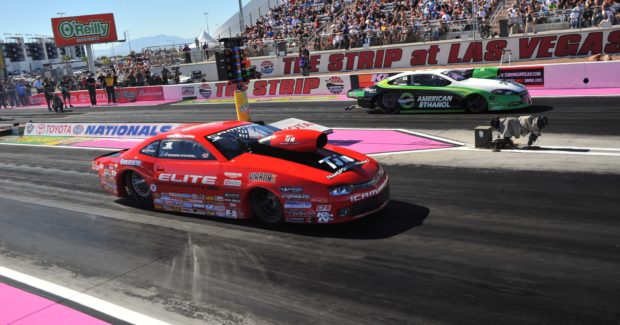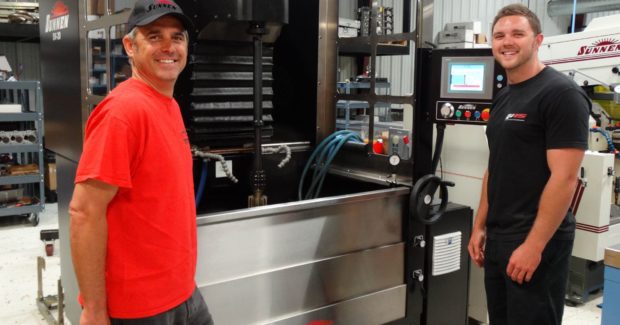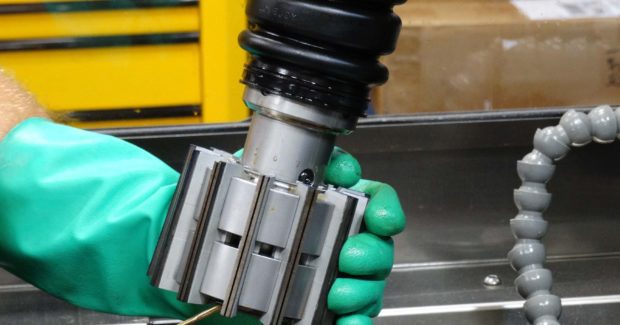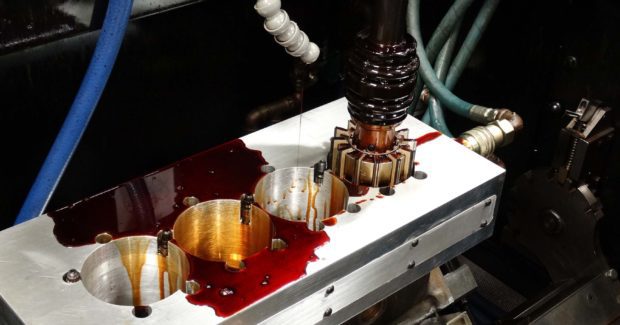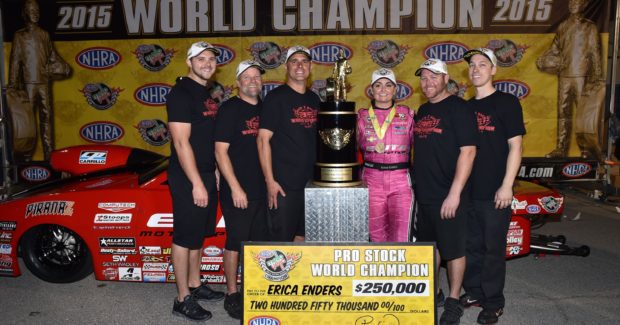Honing: A Winning Finish
From start to finish, the honing mastery of Nick Ferri is behind 57 national event NHRA Pro Stock victories and five championships, including back-to-back titles for 2015 champion Erica Enders-Stevens.
Posted: September 6, 2016
“Winning finish” has a double meaning for Elite Performance / Elite Motorsports, LLC (Wynnewood, OK), where the honing expertise of co-owner Nick Ferri has put the winning finish into engines behind 57 national NHRA Pro Stock wins and five championships, including back-to-back titles for 2015 Pro Stock Champion Erica Enders-Stevens. Ferri says honing finish rates a “10” in importance for engine seal-up, which translates into higher vacuum, greater fuel pull and ultimate track performance.
After 30 years of developing his honing expertise and secrets in several engine shops on various machine tools from Sunnen Products Company (St. Louis, MO), Ferri says he has taken his science to a higher level with greater control, flexibility and repeatability in what he can achieve using a new computer-controlled SV-20 machine and multi-stone diamond abrasives. “With today’s thinner rings and inherently lower ring tension, you need the bore geometry and low-friction sealing surface in the bore that get the most from your rings,” he explains. “The computer-controlled hone head and stroker on this machine provide flexibility for fine tuning and repeating surface finishes, overstroke, and crosshatch pattern. It all contributes to our performance on the track.”
Ferri started his career at Madcap Racing Engines in 1986 and later worked at a number of other shops, refining his honing recipes at each stop. He began with a CK10 machine, then a CK21. In December 2012, he teamed with Richard Freeman of Elite Motorsports to purchase the equipment of a North Carolina engine shop, which was then moved to Wynnewood, the home of various Freeman enterprises. Freeman and his family have a history in the automotive business, including dealerships, drag racing, and race-related equipment.
The objective of the new company: establish an Elite-branded engine building operation to support cars sponsored by Elite Motorsports – including the one driven by Erica Enders-Stevens – then build a larger business from there. “We are all about Pro Stock engines,” notes Ferri. “We started with just two, but today we have eight engines we can run in rotation as we campaign three cars full time and one part time. We also produce engines for sale, ranging from Stock Eliminator to Pro Mod and even some engines for other types of motorsports.”
The Pro Stock engines for Elite Motorsports cars start with an OEM block. In the case of Erica Enders-Stevens’ Camaro, it was a 500-cid GM DRCE 2 block of CGI. “Elite Performance specializes in the high-end engine work that’s most important to final engine performance,” adds Ferri. “We have the machines for our part of the work, but farm out much of the basic machining to a few shops we trust.”
Honing these CGI blocks is a specialty for Ferri. “Everyone thinks it’s all about the heads and cam in these short blocks, but I learned early on that ring seal makes or breaks track performance,” he says. “Your other components won’t make up for a lack of good seal. You can see this in the fuel pull on the dyno, and I use this as a key metric. For example, you can have two motors make the same power on the dyno, but one will pull more fuel than the other. On the track, the one pulling more fuel will be the winner. How they pull fuel and run down the track is all about ring seal. We’ve proven we can make the ‘23’ ring work, and though it’s only a slight weight and inertia advantage, it makes a difference in engine acceleration. But when you run a ring of that size and tension at 11,000 rpm, it has to be flat against the piston lands and well sealed so that the condition of the cylinder wall is crucial. We do leakage testing on our engines, but think vacuum is a more important metric. On a healthy engine, we can pull a 22 in vacuum with the oil pump alone. Our Pro Stock engines conservatively dyno around 1,420 hp and 800+ ft-lb torque. We use 0.023 in tungsten hard-coated top rings, with a Napier second ring, and 2 mm oil rings.”
The piston is important, too. Ferri explains that it must be well designed and stable in the bore to keep the rings flat. But cylinder finish and geometry, which create the other half of the seal interface, are bigger factors because they have so many variables, he emphasizes. “Our new SV-20 with a true vertical stroke, plus special tooling and abrasives, allows us to produce a rounder, straighter bore than possible with the rocker-type machines,” he says. “Setup of the hone head and stroker is through the computer control, so it’s precise and repeatable. The servo-driven stroker allows precision control of the stroke reversal point, eliminating all the manual adjustments and variability of earlier machines. In a perfect world, we would want at least 3/8 in overstroke, but we’re lucky to get ¼ in because of our deck height and cylinder lengths. We try to get the tool as close as possible to the top of the main web without contacting it, and it’s much easier to do this with a computer-controlled, vertical stroker.”
Ferri notes how the diamond stones in the 12-stone honing head have been a great aid in achieving good bore geometry on the total cylinder length. “In the past, we would make tapered ‘cheater’ stones to take out more metal at the bottom of the bore to get the taper out,” he explains. “The multi-stone diamond tool produces excellent roundness without special work. This much abrasive contact in the bore also requires a powerful spindle to turn the tool without chatter, which can ruin a finish. This machine handles it easily. Spindle reversal was another new capability on this machine, and we do utilize reversal but are still working to determine how and when to use it for the best effect.”
According to Sunnen, spindle reversal in a cylinder bore provides quite a few advantages and duplicates the capabilities of machines used by the OEMs. It can be used anytime in the process, but is especially helpful during the finishing strokes. It requires programmable spindle control and a honing tool/abrasives that can be run in both directions. Spindle reversal helps create a slightly rounder bore and aids in achieving the desired surface finish. Reversing causes the honing stones to take out any less-than-round shape left after initial passes, while shaping up and dressing the stones themselves. Reversing the spindle, with abrasives or a brush, also aids in removing folded-over metal and cleaning out “honing trash” hiding in the valleys of the surface. On a more subtle level, reversing the tool applies force to the block from the opposite direction, allowing the workpiece to “breathe.”
On a new block, Ferri will use 150-grit diamond stones to remove stock, then switch to 400-grit and hone to size. “I don’t like to hone in one hole for a long time, so may limit it to 20 or 30 strokes and make multiple passes around the block, reversing the spindle direction as we get to final size,” he explains. “We’ll then plateau with 900-grit diamond and brush at various stages, mostly to remove folded metal and trash from the surface. All these grits can produce a huge variety of finishes, depending on the pressure applied. After plateauing, we’ll measure our surface numbers. With lower tension rings, I prefer to have the rings take off most of the surface peaks during the first pull. I believe this optimizes our seal-up.”
Ferri also learned the value of honing with a heated torque plate. “I have seen over 0.001 in expansion in the top of a cylinder as the block rises from ambient to 120 deg F. If we hot hone at 120 deg and make the bore straight, it will then be looser at the bottom when measured at ambient. On the flip side, I can pull a hot-honed block after 30 to 40 runs, tear it down, put it in the hone, bring it to temperature, and after just two strokes there won’t be one shadow in the bore. Others who don’t hot hone may have to take out 3 tenths to 4 tenths to clean out the shadows around the bolt holes. If anything, hot honing from the start of a block’s life has saved me lots of time in salvaging used blocks.” Though he does not disclose details, Ferri says he looks at Rk, Rvk and Rpk surface parameters, not Ra or Rz. He has used crosshatch angles from 30 to near 40, but says the sweet spot is midrange.
“I’ve been very lucky to work with some well-resourced groups that have allowed me to bring my skills up to the level they are,” smiles Ferri. “With the support of Freeman Motorsports and drivers like Erica Enders-Stevens on the starting line, we hope our winning cylinder finish will be behind many more winning race finishes and championships.”
Elite Performance / Elite Motorsports, LLC, 26058 North County Road 3249, Wynnewood, OK 73098, 405-665-2727, www.elitemotorsportsllc.com.
Sunnen Products Company, 7910 Manchester Road, St. Louis, MO 63143, 314-781-2100, Fax: 314-951-2718, bdavis@sunnen.com, www.sunnen.com.

